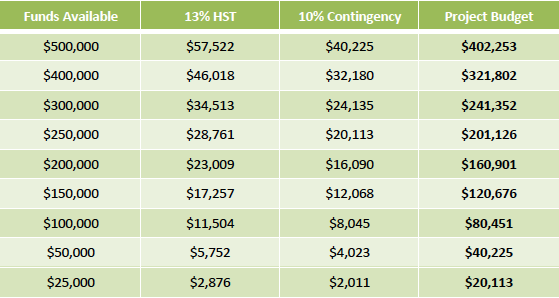DEFINING THE PROJECT BUDGET

Our involvement in a project usually begins after a design has been completed (although we can be involved earlier as part of an integrated design approach) and we start by reviewing the design, speaking with the clients and/or architect and developing a cost estimate. We then work with the clients and architect to refine the scope of work so that it is consistent with the project budget, a process that may require alterations to the design.
At GH our motto is “Renovations Done Responsibly”, and part of that responsibility is managing the project budget effectively (the other part is building sustainably and to best-practice standards). We find that our clients value and appreciate our honesty especially when it comes to defining the project budget in the early stages and managing expectations relative to costs.
Two very important and often-overlooked factors affect the budget right from the start; these are: taxes (you guessed it) and a contingency fund. These two factors instantly reduce the budget by 23% to 33% (13% HST and 10% to 20% contingency). The table below, which is an excerpt from our GH Client Handbook, demonstrates the effect these two factors have on the project budget.
We can see that $500K in the bank will only allow for a $400K build once taxes and a 10% contingency are considered.
Taxes are for the most part unavoidable. For new builds or full-gut renovations, there is a federal HST rebate program that can refund up to $16K of HST paid on applicable project expenses.
The contingency fund covers the unexpected conditions that weren’t accounted for in the original project budget. These are mainly due to concealed existing conditions that must be rectified for safety reasons or for building code compliance. Adverse weather conditions, permitting delays, and design changes can also trigger increased costs. Most problems are usually discovered in the demolition phase after finishes have been removed to expose the structure, wiring, plumbing, and HVAC. Some past examples that required use of the contingency fund are:
- Discovery of asbestos, lead, or other hazardous material requiring specialized removal. We’ve found that if any work was completed in the home between the 40s and late 70s, then asbestos is almost certain to be present. Ontario regulations require a Designated Substances Survey (DSS), which will identify any hazardous material in the work area. We recommend that homeowners have a DSS completed before we mobilize on site to avoid delays relating to these unexpected discoveries.
- Unsafe Wiring – Even though all the lights and plugs may be working in the house, there may be wiring hidden behind finishes that is unsafe or does not meet the electrical code. Once uncovered, these must be rectified.
- Non-Compliant Plumbing – Similar to the unsafe wiring, even though the plumbing might be functional, it might not be to code. If our work affects or connects to anything that is unsafe or not to code, then we must rectify the problem.
- Structural Defects – We’ll often uncover structural elements that have been removed or compromised, such as a load-bearing interior partition wall with a new opening. Such defects need to be remedied before proceeding. In addition, structural requirements are generally more robust now than they have been in the past, so it’s often advisable to reinforce existing structures while they’re exposed. An example of this is sistering floor joists and installing a new subfloor to eliminate sagging, creaks, bounciness, drywall cracking, etc.
- Design Changes – Often a design might have a different feel once the walls are framed and one can experience the space first hand rather than on paper or through a rendering. After making a large commitment to a renovation, it sometimes makes sense to “go the extra mile” to make sure you are completely happy with the result. These situations do come up, and so it’s a good idea to have a little money set aside to be able to execute the additional work.
Although accounting for a contingency in the beginning of a project reduces the budget; planning in advance for the unexpected is the informed and responsible thing to do, and can avoid a lot of stress and financial strain in later stages. Renovating your home can be a challenging experience; but with realistic budgeting and responsible planning, it will also be extremely rewarding!
